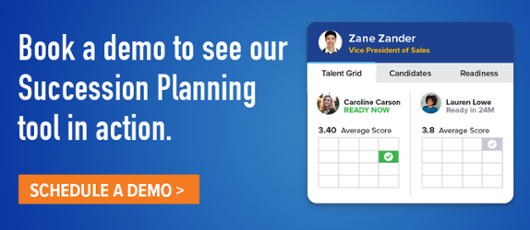Unlocking Succession Planning: HR Pro Strategies
With the turnover rate of executives at an all-time high, succession planning is a critical strategic initiative for employee development, retention, and organizational security. Succession planning makes it easier for the business to plan for the unexpected and replace top talent seamlessly.
As the demand for skilled professionals continues to rise, succession planning enables companies to proactively identify, nurture, and retain high-potential employees. By cultivating a robust pipeline of internal talent, organizations not only ensure a seamless transition of leadership. They can foster a culture of growth, engagement, and professional development.
In this article, we’ll cover:
- What succession planning is
- Why it’s important
- How to build your succession plan
- How to utilize technology to implement your succession plan at scale
What is succession planning?
Succession planning is the process of identifying the critical positions within your organization and developing action plans for high-performing individuals to be ready to fill those positions. It ensures you have the right people, in the right jobs, at the right time—today and tomorrow.
Done well, succession planning helps organizations be ready when talent needs arise. It guides talent development over time and identifies talent risk.
But succession planning is so much more than simply picking replacements—leaders need to understand how open positions and bad hiring decisions can potentially impact the company.
An effective succession plan equips identified successors with the skills and competencies needed in their future role. By using a customized career development plan, you can promote employee growth and ensure your successors make the right impact. Not to mention, the right succession planning tool enables you to utilize objective metrics—like performance reviews and engagement scores—to help you fill open positions when top leaders leave.
Why is succession planning important?
Succession planning should never be an afterthought. That’s because succession planning plays a critical role in the long-term success and sustainability of your organization.
Your plan provides you with a strategic initiative to proactively address talent gaps, minimize business disruptions, and foster a culture of career growth and development. Here are 8 top reasons why succession planning is critical to your business success.
1. Provides a guideline for training and development
The right succession plan will guide your training and development plans and prepare high-potential employees for their future role. Your succession plan will highlight areas for growth so they can develop critical skill sets, empowering them to thrive now and in the future.
Development and training for succession planning isn’t the only benefit to be found. In fact, our research shows that 79% of employees who had access to a formal development program were engaged (compared to only 58% of employees whose organization didn’t have a formal program).
Of employees who participate in learning and development opportunities:
- 71% feel motivated
- 55% feel empowered
- 64% feel more equipped to do their job
While succession planning is one reason to invest in development and training, it’s certainly not the only high-potential benefit.
2. Reduces costs to recruit and hire talent
The costs associated with recruiting and hiring top talent will soar if you don’t have a plan in place. If top roles go unfilled for too long, you might be forced to make rushed and costly hiring decisions, only to regret them later.
Hiring top talent typically requires bonus offerings and relocation costs. And when you aren’t confident in your replacement, your business may continue to lose money. By shaping a talent pipeline, you’ll safeguard the return on your hiring investment with sound successors.
In the case that your successors come from within the company, you won’t need to recruit externally, which reduces costs further. You’ll be able to invest the money you save elsewhere—like in training and development.
3. Identifies key leaders
With the right approach to succession planning, you can identify, develop, and retain key employees who might perform well in top roles. This way, you can measure all of your options and make the best decisions when it comes to successors. Plus, you can ensure your succession pool aligns with your diversity and inclusion goals.
Utilizing reporting and metrics to connect performance, development, and engagement is one of the most critical elements of a high impact succession plan.
4. Promotes long-term planning
Businesses that aim for long-term success need long-term plans. In the face of rapid change, you need strategic plans to guide your actions. With a thorough succession plan, you’ll create a path to retirement for top leaders and ensure their expertise is transferred to their successor. As you outline clear plans, you’ll be better equipped to grow and evolve as a successful organization.
5. Mitigates risk
Succession planning helps you protect your company. Let’s face it, your top leaders may be swayed to leave for higher pay or be affected by a serious illness, for example. Critical roles, such as the head of cybersecurity or your lead software engineer who knows the code like the back of her hand, are essential for business risk and continuity. A well-developed succession plan can mitigate these risks and ensure that key roles are always filled with qualified individuals, preparing the next generation of leaders to step into these important positions.
Whatever the case, when critical roles within your organization go unfilled for too long, your business success may be put in jeopardy. But with succession planning, you’ll have a plan when change happens so that your business isn’t vulnerable.
6. Helps leaders leave a legacy
When leaders are aware of their successors, they’re able to provide mentorship and share knowledge. This way, when top leaders exit, their contributions and impact won’t leave with them. All the hard work put in throughout the years will be translated into future efforts of their successor, so your leaders can leave a lasting mark on the organization.
7. Shapes an exit strategy
Succession plans ensure leadership exits are smooth, seamless, and non-detrimental to profitability. An effective plan outlines replacements for key people so that your business can run properly when they leave. If you're blindsided by top talent loss and have no back-up plan, your business is likely to face negative impact.
8. Promotes progression
Succession planning helps you shape the mindset that’s key for continuity. While replacement identification is important, succession planning promotes big-picture growth. When leaders continually think about how certain events can affect the business as a whole, they’ll be more agile and resilient in the face of unexpected events.
How to create a succession plan
If you’re in charge of crafting the succession plan for your business - fear not! While every organization is different, the recipe for a successful succession plan is similar no matter how complex your organization is. Here are the steps to create a succession plan:
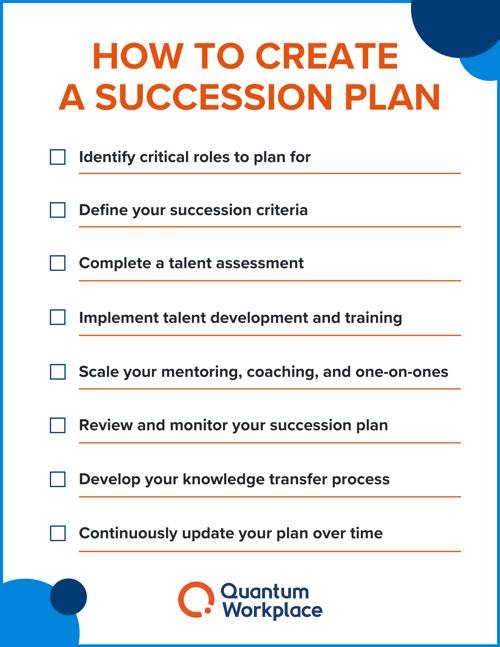
1. Identify critical roles to plan for
The first step in a succession plan is to identify the key positions within the organization that are critical for its continued success. Sometimes these positions are leadership roles. Sometimes, they’re mid-level.
No matter what the title is, you should identify roles where the operation, strategy, and decision-making of your organization would be dramatically affected if they were to be suddenly empty.
Here are some guidelines on how to identify critical roles for succession planning:
The role has a high impact on business operations.
You’ll want to consider roles that have a significant impact on the organization's core operations, strategic initiatives, and overall performance.
The role involves a high level of leadership and decision-making.
Be sure to identify roles that involve critical decision-making authority and require strong leadership skills to effectively guide teams and drive results.
The role requires specialized expertise, training, or experience.
The talent pool for certain areas of expertise is getting smaller and smaller. You’ll want to consider those roles that require specialized knowledge, unique skill sets, or industry-specific expertise.
The role has a high talent scarcity or risk.
Evaluate roles where there may be a scarcity of talent in the external market or a higher risk of succession gaps, such as positions with specific technical requirements or leadership demands.
The role is required for future organizational success.
It can be hard to anticipate the future needs of your business, but it’s critical to do so when succession planning. Identify those roles that will be pivotal for achieving long-term goals and addressing emerging challenges or opportunities.
2. Define your succession criteria
Once you have your critical roles identified, it’s time to establish your succession criteria. But what does that mean?
Succession criteria are the skillsets, competencies, experiences, and training required for your potential successors. These criteria act as your benchmark for evaluating the readiness of candidates to fill your roles.
It’s possible that the criteria may be different based on the role you’re looking to plan for. Here are some examples of criteria you may want to consider:
- Core competencies required for the role including both technical and leadership capabilities.
- The employee's experience level and track record within the organization
- The employee's professional goals drive success and contribute to the long-term success and vision of the organization
3. Complete a talent assessment
Now that you have your roles and criteria defined, it’s time to complete a talent assessment. Your succession plan will require you to assess your talent pool within the organization to identify potential successors. This assessment includes evaluating employees' performance, potential, and readiness to take on higher-level responsibilities. This is where your criteria comes into play.
4. Implement talent development and training
Now that you have your talent pool based on your assessment, you can refocus your efforts on development and training. This usually involves creating a personalized development plan for your candidates to enhance their skills, knowledge, and competencies required for future leadership roles.
There is an overwhelming need for businesses to invest in career growth and development. Our research shows the top three opportunities employees want include leadership development programs, cross training, and skills-based training for an advanced role.
5. Scale your mentoring, coaching, and one-on-ones
Remember, talent development is never a one-and-done investment. Be sure to provide mentoring, coaching, and regular one-on-one opportunities to your potential successors. Ongoing development, as part of a comprehensive talent management plan, is crucial for the success of your succession plan. Senior leaders within the organization can guide and support successors in their professional growth, sharing their knowledge and experiences to help them prepare for future leadership positions.
6. Review and monitor your succession plan
Regularly reviewing and monitoring the progress of the succession plan is crucial for human resources (HR) professionals. This usually involves tracking the development and performance of potential successors, evaluating their readiness for advancement, and making adjustments to the plan as needed. Succession planning technology can make this process much easier by providing tools for you to set criteria, identify candidates, and implement development strategies before there is a desperate need to fill an empty role.
7. Develop your knowledge transfer process
Once your successor is identified and ready to assume a critical role, your succession plan should include a clear, standardized transition process. This process will look different for every role. But it’s likely to include a comprehensive handover of responsibilities and knowledge transfer, which will ensure a smooth transfer of leadership and decision-making authority.
8. Continuously update your plan over time
Just like any successful HR initiative, a successful succession plan requires continuous evaluation and refinement. Use your succession planning technology to collect continuous feedback from stakeholders, analyze the plan's effectiveness, and implement adjustments based on changing organizational needs.
Remember - a great succession plan isn’t made on the fly. And succession planning offers an incredible opportunity to boost talent growth and development from within your existing employee base.
If you’ve been managing your succession plan with disparate software systems, spreadsheets, and email threads, it may be time for an upgrade. Succession planning software makes your succession plan easy to build, launch, and scale over time.
Succession planning case study
Valet Living is an industry leader in the multifamily housing sector, providing a wide range of services to apartment communities across 40 states. The company was facing significant challenges in their talent management and career development processes. Less than half of operations team associates felt they had room for professional growth within the company. But visualizing talent across such a large organization was a considerable hurdle.
“We wanted to connect the dots so that great talent wasn’t lost, and associates felt that the organization cared about more than just their current role,” said Nicole Davies, Vice President of People & Culture at Valet Living.
The company implemented a transformative strategy to revolutionize their practices using Quantum Workplace. They leveraged the platform’s Succession Planning tools to create unique career pathing for each employee, replacing their traditional linear trajectory. They enabled people leaders to identify employees’ readiness factors and assess their potential for advancement.
In addition to filling critical open roles, Quantum Workplace helped create a bird’s eye view of talent that helped open doors for associates to work on special projects, participate in learning opportunities, and make connections across the organization that weren’t previously possible.
Read more about Valet Living’s Success Story here >>
The key features of succession planning software
By leveraging the capabilities of succession planning software, you’re one step closer to a seamless and efficient succession plan.
Modern technology can take the pain out of the process and streamline your succession strategy. With the right tools, you can propel employee growth, guide change, and drive business success. These are the top benefits of a comprehensive succession planning tool:
1. Evaluates talent readiness
Succession planning has traditionally been an HR responsibility. But managers most directly influence the development of identified successors. You need a succession planning process that empowers managers to take an active role in successor development—and that holds them accountable for movement.
To make the best hiring decisions, leaders need to be able to visualize their talent all in one place and understand the full scope of each individual’s skill set. With the right tools, you can identify your highest potential talent and include them in your succession plans.
Most traditional succession planning tools evaluate talent readiness in multi-year increments:
- Ready in 1-2 years
- Ready in 3-5 years
- Ready in 5-7 years
But it’s too difficult to drive action and make adjustments with this model. To do that, your process must focus on development in smaller increments. A better practice is to evaluate talent readiness in 12-month increments, such as:
- Ready now
- Ready in 12 months
- Ready in 24 months
- Ready in 36 months
- On the radar
These 12-month increments help managers take a more active and tangible role in successor development. By focusing on a smaller span of time, it’s easier to build a development plan and to measure the success of that plan. Smaller increments of time also help hold managers accountable for intentional development that includes stretch assignments, which drive employees toward readiness for leadership roles.
For example, let’s say Susan needs to focus on two specific areas to be ready for a VP of Sales role in 12 months. Susan’s manager should be working with her on a development plan that drives her toward “Ready Now.” If, after 12 months, her readiness hasn’t changed, her manager should be held accountable for that lack of movement.
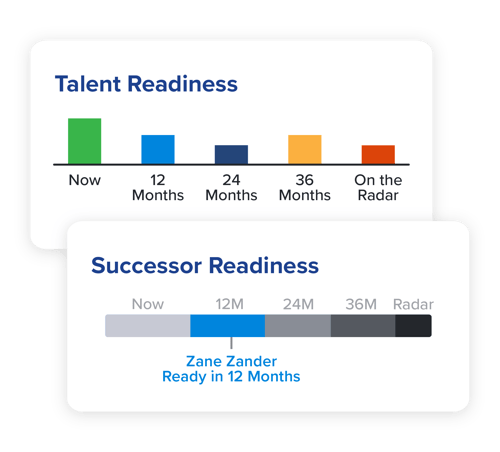
2. Regularly checks in on talent development
To help guide successors on their journey to a future role, you need to understand where they are today and their overall trajectory. And you need to check in along the way. Two ways to do this are to sync your success planning conversations with talent review data and documented development goals.
Syncing succession planning and talent reviews
Think about your talent reviews as a regular check-in on succession plans. Quarterly talent reviews help you evaluate and measure successor growth and development along the way. By understanding successor impact, growth trajectory, and retention risk, you can be more agile and adjust your succession plans as needed.
A robust succession planning platform will work seamlessly with your talent reviews and employee goals. When you’re able to measure and align performance with your succession plans, you can identify the right talent and ensure they’re growing. This way, you can create continuity in critical roles and drive business success for years to come.
Syncing succession planning and development goals
A key result of your succession planning process should be developmental goals for potential successors. Goals and stretch projects can be another measurement of candidate readiness. With goal tracking, leaders can see how a potential successor approaches new opportunities and can help plan for future transitions.
The right platform will bring employee skills gaps to the surface when they are identified as successors. This way, you can promote growth and development in the areas that matter. When employees are prepared to fill critical roles, you’ll be able to conduct business as usual in the face of leadership loss.
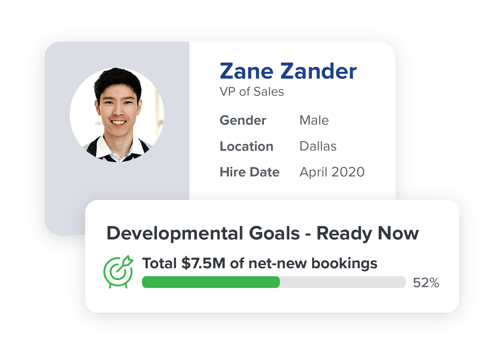
3. Monitors your talent risk
The work is not done once your succession plan is created. You need to actively evaluate areas of risk within your plan. Be sure your succession planning tool integrates with your HRIS data—and that it’s set up to send alerts around key insights and events like:
- A critical role is empty
- A role has no identified successor
- A successor is being considered for multiple roles
If you have multiple successors being considered for one role, be proactive about the development plans of the ones who don’t end up getting the role. You want to prevent attrition of those high potential team members—and keep them engaged and motivated to potentially fill future roles.
The same applies to successors who are “Ready Now” for a role that isn’t open. You’ll want to keep them challenged with stretch projects, interim positions, committees, etc.
Remember: Succession planning is not a one-and-done initiative. It’s essential to recognize that succession planning requires continuous evaluation, adjustment, and monitoring to align with organizational changes, evolving talent needs, and emerging leadership trends. Succession planning software enables you to regularly review and refine your talent pool over time.
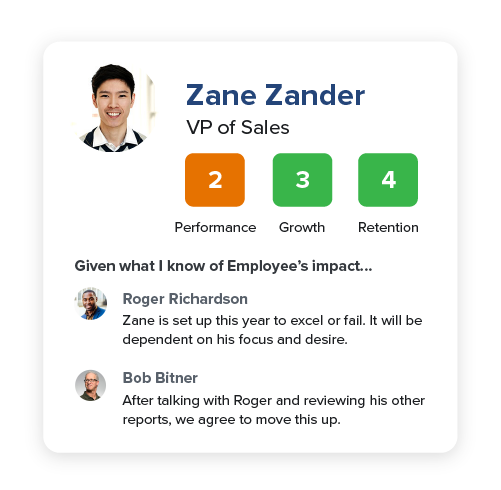
4. Provides reporting on your DEI aspirations
Checking your succession plan against your DEI goals helps you work smarter, not harder. It’s important to consider the implications of your future plans on your diversity and inclusion initiatives and metrics. But keeping track of diversity metrics and plans can be tiresome and inconclusive without the right technology. A robust succession platform enables you to keep a pulse on your metrics and ensure that your top positions are filled with inclusivity in mind.
You may want to:
- See younger generations developed for leadership
- Ensure accurate distribution of roles across locations
- See higher gender or ethnic diversity on your leadership team
Promoting diversity and inclusion in succession planning can be a challenge for organizations striving for equitable representation in leadership positions. It is crucial to proactively identify and address biases, provide equal opportunities for underrepresented groups, and leverage tools and technologies that support diversity analytics to ensure fair and inclusive succession planning processes.
Regardless of what you’re trying to achieve, a strong succession plan should align with your diversity, equity, and inclusion goals.
5. Tracks the success of your plan
A succession plan is most successful when leaders and managers regularly review and optimize the plan. You should track completed successions as they happen. And the status and progress of the plan should always be up-to-date and easy for leaders across the organization to view and understand.
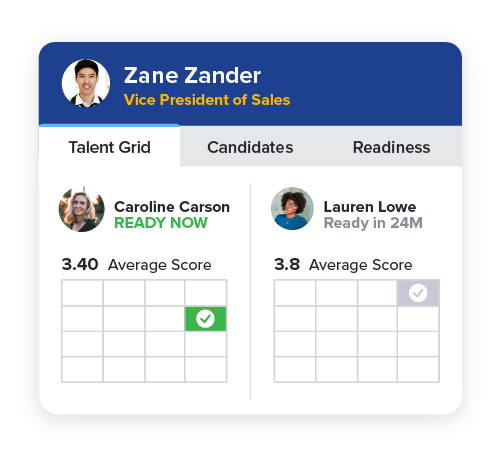
6. Provides visibility & makes it easy to collaborate.
Collaboration is critical. And that’s why you should look for a tool that not only provides insightful reporting, but the ability for HR and key stakeholders to communicate centrally. Collaboration tools can help you streamline the nomination process and reduce administrative burden.
A savvy solution will allow multiple users to nominate candidates for a single role simultaneously. This facilitates collective input and diverse perspectives in the succession planning process.
But what about visibility concerns?
Make sure you select a tool that provides controlled access and restricts sensitive information to authorized individuals. This will enable you to maintain confidentiality at the top of the organization while fostering transparency and collaboration within your designated user groups.
7. Enables solid decision making when talent leaves
When your top leaders unexpectedly, it’s important to have a plan in place so you’re not scrambling to fill their role. Effective technology identifies the best fit for each role to make sound, measured hiring decisions and reduce negative business impact when key players leave.
One of the biggest reasons that succession plans fail is that the organization has a limited pool of qualified individuals ready to step into critical roles.
But it’s possible to proactively address this. Use your technology to identify and then implement talent development programs that focus on nurturing your high-potential employees, providing them with opportunities for growth, and aligning their development plans with the organization's succession needs. This helps expand the pool of potential successors over time. Not to mention, your software can help you identify gaps in training so you can make the best decisions when your talent leaves.
8. Provides on-demand reporting for your investors
Succession planning is a must, especially when your company is publicly traded. A streamlined tool will keep your succession plan up to date, ready, and at your investors’ fingertips to illustrate your business’s longevity.
Cultivating a robust pipeline of internal talent to nurture, develop, and retain is more critical than ever. In fact, some industries—like credit unions—are now requiring organizations to establish succession plans. But you’re not alone if you feel like your organization hasn’t found a process you’re confident in.
Many leaders have yet to figure out the best way to navigate succession planning, spending too many hours in spreadsheets that go nowhere. What’s troubling is that the most important part of a succession plan—the actual plan!—is often overlooked.
Simplify your succession planning process with Quantum Workplace
The right tools can help you navigate succession planning like a well-oiled machine. Quantum Workplace’s succession planning tool helps ensure you have the right people in the right jobs at the right time, today and in the future. It syncs seamlessly with Quantum Workplace Talent Reviews & Goals to identify and develop your best talent and create continuity in your most critical roles.
Learn more about how Quantum Workplace can help you:
- Capture talent, interest, and readiness to find the best successors for critical roles
- Help successors grow and develop so they’re ready when called upon
- Ensure your successor pool aligns with your diversity and inclusion aspirations
- Make sound decisions when critical talent leaves
- Provide a board-ready succession plan at your fingertips when you need it
Book a demo to see how our succession planning platform will work for you and your business.



